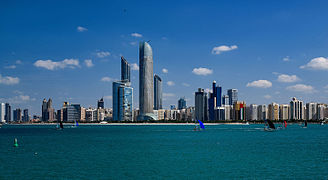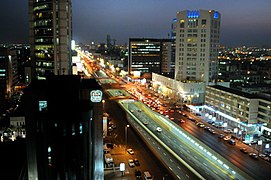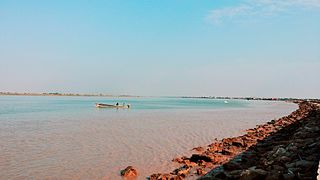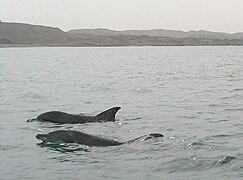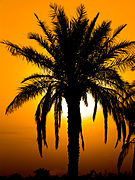Persian Gulf
| Persian Gulf | ||
|---|---|---|
Primary inflows Gulf of Oman | | |
| Basin countries | Iran, Iraq, Kuwait, Saudi Arabia, Qatar, Bahrain, United Arab Emirates and Oman (exclave of Musandam) | |
| Max. length | 989 km (615 mi) | |
| Surface area | 251,000 km2 (97,000 sq mi) | |
| Average depth | 50 m (160 ft) | |
| Max. depth | 90 m (300 ft) | |
| Water volume | 8,780 km3 (2,100 cu mi) | |
The Persian Gulf (
The Persian Gulf has many fishing grounds, extensive
The Persian Gulf is in the Persian Gulf Basin, which is of Cenozoic origin and related to the subduction of the Arabian Plate under the Zagros Mountains.[2] The current flooding of the basin started 15,000 years ago due to rising sea levels of the Holocene glacial retreat.[3]
Geography
The International Hydrographic Organization defines the Persian Gulf's southern limit as "The Northwestern limit of Gulf of Oman". This limit is defined as "A line joining Ràs Limah (25°57'N) on the coast of Arabia and Ràs al Kuh (25°48'N) on the coast of Iran (Persia)".[4]
This inland sea of some 251,000 square kilometres (96,912 sq mi) is connected to the Gulf of Oman in the east by the Strait of Hormuz; and its western end is marked by the major river delta of the Shatt al-Arab, which carries the waters of the Euphrates and the Tigris. In Iran, this is called "Arvand Rud" (lit. Swift River). Its length is 989 kilometres (615 miles), with Iran covering most of the northern coast and Saudi Arabia most of the southern coast. The Persian Gulf is about 56 km (35 mi) wide at its narrowest, in the Strait of Hormuz. Overall, the waters are very shallow, with a maximum depth of 90 metres (295 feet) and an average depth of 50 metres (164 feet).
Countries with a coastline on the Persian Gulf are (clockwise, from north): Iran; Oman's Musandam exclave; the United Arab Emirates; Saudi Arabia; Qatar, on a peninsula off the Saudi coast; Bahrain, an island nation; Kuwait; and Iraq in the northwest. Various small islands also lie within the Persian Gulf, some of which are the subject of territorial disputes between the states in the region.
Exclusive economic zone
| Number | Country | Area (km2) |
|---|---|---|
| 1 | 97,860 | |
| 2 | 52,455 | |
| 3 | 33,792 | |
| 4 | 31,819 | |
| 5 | 11,786 | |
| 6 | 8,826 | |
| 7 | 3,678 | |
| 8 | 540 | |
| Total | Persian Gulf | 240,756 |
Coastlines
Countries by
| Number | Country | Length |
|---|---|---|
| 1 | 1,536 | |
| 2 | 1,300 | |
| 3 | 900 | |
| 4 | 563 | |
| 5 | 499 | |
| 6 | 161 | |
| 7 | 100 | |
| 8 | 58 | |
| Total | Persian Gulf | 5,117 |
Islands
The Persian Gulf is home to many islands such as Bahrain, an Arab state. Geographically, the biggest island in the Persian Gulf is
Oceanography
The Persian Gulf is connected to the Indian Ocean through the Strait of Hormuz. Writing the water balance budget for the Persian Gulf, the inputs are river discharges from Iran and Iraq (estimated to be 2,000 cubic metres (71,000 cu ft) per second), as well as precipitation over the sea which is around 180 mm (7.1 in)/year in Qeshm Island. The evaporation of the sea is high, so that after considering river discharge and rain contributions, there is still a deficit of 416 cubic kilometres (100 cu mi) per year.[8] This difference is supplied by currents at the Strait of Hormuz. The water from the Persian Gulf has a higher salinity, and therefore exits from the bottom of the Strait, while ocean water with less salinity flows in through the top. Another study revealed the following numbers for water exchanges for the Persian Gulf: evaporation = –1.84 m (6.0 ft)/year, precipitation = 0.08 m (0.26 ft)/year, inflow from the Strait = 33.66 m (110.4 ft)/year, outflow from the Strait = -32.11 m (105.3 ft)/year, and the balance is 0 m (0 ft)/year.[9] Data from different 3D computational fluid mechanics models, typically with spatial resolution of 3 kilometres (1.9 mi) and depth each element equal to 1–10 metres (3.3–32.8 ft) are predominantly used in computer models.
Name
Historical names

Before being given its present name, the Persian Gulf was called many different names. The
During the years 550 to 330 BC, coinciding with the sovereignty of the Achaemenid Persian Empire over the Middle East area, especially the whole part of the Persian Gulf and some parts of the Arabian Peninsula, the name of "Persian (Pars) Sea" is widely found in the compiled written texts.[1]
At the same period, there is the inscription and engraving of Darius the Great, which belongs to the fifth century BC:[1] King Darius says:[14]
I ordered to dig this (
Darius the Great's Suez Inscriptions
In
Modern naming dispute
The body of water is historically and internationally known as the Persian Gulf.[18][19][20] Arab governments refer to it as the Arabian Gulf or The Gulf,[21] and other countries and organizations have begun using Arabian Gulf.[22] The name Gulf of Iran (Persian Gulf) is used by the International Hydrographic Organization.[23]
The dispute in naming has become especially prevalent since the 1960s.[24] Rivalry between Iran and some Arab states, along with the emergence of pan-Arabism and Arab nationalism, has seen the name "Arabian Gulf" become predominant in most Arab countries.[25][26] Names beyond these two have also been applied to or proposed for this body of water.
History
Ancient history
The region of the Persian Gulf has been inhabited since the Paleolithic.[27] During most of the Last Glacial Period (115,000–11,700 years Before Present), due to lowered sea levels (reaching around 125 metres (410 ft) metres below present values during the Last Glacial Maximum) combined with the shallow depth of the Gulf (on average around 35 metres (115 ft) and at max around 100 metres (330 ft) metres depth) most of the Persian Gulf was exposed as dry land,[28] forming a flat floodplain where a number of rivers converged. This region may have served as an environmental refuge for early humans during periodic hyperarid climate oscillations. The modern marine Gulf was formed when sea level rose during the early Holocene, from around 12,000 to 6,000 years ago. The flooding of the Gulf may have stimulated the development of Neolithic farming cultures in regions of the Middle East adjacent to the Gulf.[27]
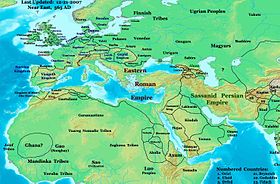
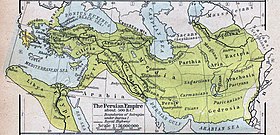

The world's oldest known civilization (Sumer) developed along the Persian Gulf and southern Mesopotamia.[29] The oldest evidence in the world for seagoing vessels has been found at H3 in Kuwait, dating to the mid-sixth millennium BC, when the Gulf was part of an extensive trade network that involved the Ubaid settlements in Mesopotamia and communities along the entire Gulf coast.[30]
For most of the early history of the settlements in the Persian Gulf, the southern shores were ruled by a series of nomadic tribes. During the end of the
Between 625 BC and 226 AD, the northern side was dominated by a succession of Persian empires including the
The Achaemenid high naval command had established major naval bases located along Shatt al-Arab river, Bahrain, Oman, and Yemen. The Persian fleet would soon not only be used for peacekeeping purposes along the Shatt al-Arab but would also open the door to trade with India via Persian Gulf.[32][33]
Following the fall of Achaemenid Empire, and after the fall of the
Colonial era
Portuguese influence in the Persian Gulf lasted for 250 years;
Modern history

The Persian Gulf was a battlefield of the 1980–1988 Iran–Iraq War, in which each side attacked the other's oil tankers. It is the namesake of the 1991 Gulf War, the largely air- and land-based conflict that followed Iraq's invasion of Kuwait. The United States' role in the Persian Gulf grew in the second half of the Twentieth Century.[47] On July 3, 1988, Iran Air Flight 655 was shot down by the U.S. military (which had mistaken the Airbus A300 operating the flight for an Iranian F-14 Tomcat) while it was flying over the Persian Gulf, killing all 290 people on board.[48] The United Kingdom maintains a profile in the region; in 2006 alone, over 1 million British nationals visited Dubai.[49][50] In 2018, the UK opened a permanent military base, HMS Jufair, in the Persian Gulf, the first since it withdrew from East of Suez in 1971 and is developing a support facility in Oman.[51][52][53]
Cities and population
Eight nations have coasts along the Persian Gulf: Bahrain, Iran, Iraq, Kuwait, Oman, Qatar, Saudi Arabia, and the United Arab Emirates. The Persian gulf's strategic location has made it an ideal place for human development over time. Today, many major cities of the Middle East are located in this region.
|
Wildlife
The wildlife of the Persian Gulf is diverse, and entirely unique because of the Persian Gulf's geographic distribution and its isolation from the international waters only breached by the narrow Strait of Hormuz. The Persian Gulf has hosted some of the most magnificent marine fauna and flora, some of which are near extirpation or at serious environmental risk. From corals, to dugongs, Persian Gulf is a diverse cradle for many species who depend on each other for survival. However, the Persian Gulf is not as biologically diverse as the Red Sea.[54]
Overall, the wildlife of the Persian Gulf is endangered from both global factors, and regional, local negligence. Most pollution is from ships; land generated pollution counts as the second most common source of pollution.[55]
Aquatic mammals
This article contains weasel words: vague phrasing that often accompanies biased or unverifiable information. (July 2015) |
Along the
One of the more unusual marine mammals living in the Persian Gulf is the
Birds
The Persian Gulf is also home to many migratory and local birds. There is great variation in color, size, and type of the bird species that call the Persian Gulf home. Concerns regarding the endangerment of the kalbaensis subspecies of the collared kingfishers were raised by conservationists over real estate development by the United Arab Emirates and Oman.[80] Estimates from 2006 showed that only three viable nesting sites were available for this ancient bird, one located 80 miles (129 km) from Dubai, and two smaller sites in Oman.[80] Such real estate expansion could prove devastating to this subspecies. A UN plan to protect the mangroves as a biological reserve was ignored by the emirate of Sharjah, which allowed the dredging of a channel that bisects the wetland and construction of an adjacent concrete walkway.[80] Environmental watchdogs in Arabia are few, and those that do advocate the wildlife are often silenced or ignored by developers of real estate many of whom have governmental connections.[80]
Real estate development in the Persian Gulf by the United Arab Emirates and Oman also raised concerns that habitats of species such as the
Fish and reefs
The Persian Gulf is home to over 700 species of fish, most of which are native.
Flora
A great example of this
Gallery
-
Dugong mother and her offspring in shallow water
-
Indo-Pacific bottlenose dolphins off the southern shore of Iran, around Hengam Island
-
Spinner dolphins leaping in the Persian Gulf
-
Critically endangered Arabian humpback whales (being the most isolated, and the only resident population in the world) off Dhofar, Oman
-
Minoo Island
Oil and gas

The Persian Gulf and its coastal areas are the world's largest single source of petroleum,
In 2002, the Persian Gulf nations of Bahrain, Iran, Iraq, Kuwait, Qatar, Saudi Arabia, and the UAE produced about 25% of the world's oil, held nearly two-thirds of the world's crude oil reserves, and about 35% of the world's natural gas reserves.[92][93] The oil-rich countries (excluding Iraq) that have a coastline on the Persian Gulf are referred to as the Persian Gulf States. Iraq's egress to the Persian Gulf is narrow and easily blockaded, consisting of the marshy river delta of the Shatt al-Arab, which carries the waters of the Euphrates and the Tigris rivers, where the east bank is held by Iran.
See also
- Eastern Arabia
- Eastern Arabian cuisine
- Cradle of civilization
- Deluge (prehistoric)
- Musandam Peninsula
- History of the United Arab Emirates#The pearling industry and the Portuguese empire: 16th - 18th century
- Saeed bin Butti#Perpetual Maritime Truce
- Trucial States
- Sultan bin Saqr Al Qasimi#Perpetual Maritime Truce of 1853
- Persian Gulf campaign of 1809
- Persian Gulf campaign of 1819
- General Maritime Treaty of 1820
- Geography of Iran
- Geography of Saudi Arabia
- Geography of Oman
- Geography of United Arab Emirates
- Geography of Qatar
- Geography of Bahrain
- Geography of Kuwait
- Geography of Iraq
References
- ^ a b c United Nations Group of Experts on Geographical Names Working Paper No. 61 Archived 2012-10-03 at the Wayback Machine, 23rd Session, Vienna, 28 March – 4 April 2006. accessed October 9, 2010
- ^ A Brief Tectonic History of the Arabian basin. Retrieved from the website: http://www.sepmstrata.org/page.aspx?pageid=133 Archived 2018-09-17 at the Wayback Machine
- from the original on 13 April 2016. Retrieved 14 April 2016.
- ^ "Limits of Oceans and Seas, 3rd edition" (PDF). International Hydrographic Organization. 1953. Archived from the original (PDF) on 8 October 2011. Retrieved 28 December 2020.
- ^ "EEZ". www.seaaroundus.org. Retrieved 25 February 2021.
- ^ "Catches by Taxon in the waters of Oman (Musandam)". www.seaaroundus.org. Retrieved 25 February 2021.
- ^ Ramerini, Marco. "Portuguese in the Arabia and the Persian Gulf". Archived from the original on 11 September 2015. Retrieved 27 November 2010.
- .
- S2CID 14873658.
- S2CID 216032694.
- ^ Touraj Daryaee (2003). "The Persian Gulf Trade in Late Antiquity". Journal of World History. 14 (1). Archived from the original on 5 August 2013.
- ^ "Documents on the Persian Gulf's name the eternal heritage ancient time by Dr.Mohammad Ajam".
- ^ Nearchus (2013). "The Voyage of Nearchus from the Indus to the Euphrates". The Voyage of Nearchus. 1 (1).
- ^ "DZ – Livius". www.livius.org. Retrieved 28 March 2019.
- ^ Foundation, Encyclopaedia Iranica. "Welcome to Encyclopaedia Iranica". iranicaonline.org. Retrieved 8 March 2023.
- ^ K Darbandi (27 October 2007). "Gulf renamed in aversion to 'Persian'". Asia Times. Archived from the original on 27 November 2010. Retrieved 30 November 2010.
{{cite web}}: CS1 maint: unfit URL (link) - ^ Mahan Abedin (9 December 2004). "All at sea over 'the Gulf'". Asia Times. Archived from the original on 21 May 2016. Retrieved 30 November 2010.
{{cite web}}: CS1 maint: unfit URL (link) - ^ Central Intelligence Agency (CIA). "The World Fact Book". Retrieved 4 December 2010.
- ^ nationsonline.org. "Political Map of Iran". Archived from the original on 27 November 2010. Retrieved 4 December 2010.
- ^ United Nations. "United Nations Cartographic Section (Middle East Map)". Archived from the original on 30 June 2017. Retrieved 29 June 2017.
- ^ Niusha Boghrati, Omission of 'Persian Gulf' Name Angers Iran Archived 2007-01-09 at the Wayback Machine, World Press.com, December 28, 2006
- ^ Zraick, Karen (12 January 2016). "Persian (or Arabian) Gulf Is Caught in the Middle of Regional Rivalries". The New York Times. Retrieved 9 February 2022.
- ^ "Limits of Oceans and Seas, 3rd edition" (PDF). International Hydrographic Organization. 1953. p. 21. Archived from the original (PDF) on 8 October 2011. Retrieved 28 December 2020.
- S2CID 154527123.
- )
- ^ Bosworth, C. Edmund (1980). "The Nomenclature of the Persian Gulf". In Cottrell, Alvin J. (ed.). The Persian Gulf States: A General Survey. Baltimore, Maryland: Johns Hopkins University Press. pp. xvii–xxxvi. p. xxxiii:
Not until the early 1960s does a major new development occur with the adoption by the Arab states bordering on the Persian Gulf of the expression al-Khalij al-Arabi as weapon in the psychological war with Iran for political influence in the Persian Gulf; but the story of these events belongs to a subsequent chapter on modern political and diplomatic history of the Persian Gulf.
- ^ S2CID 144935980.
- .
- S2CID 144935980.
- S2CID 162674282.
- ISBN 978-90-04-09796-4. Retrieved 26 November 2010.
- ISBN 978-1-57506-120-7.
- ^ British Institute of Persian Studies. "Siraf". Archived from the original on 16 July 2011. Retrieved 24 November 2010.
- ISBN 978-90-04-24382-8.
- ^ "THE AGE OF COLONIALISM Persian Gulf States Table of Contents".
- ISBN 978-1-4669-5896-8.
- S2CID 162702326.
- ^ Archived 21 May 2013 at the Wayback Machine[dead link]
- ^ Rahman 1979, pp. 138–139
- JSTOR 195948.
- ^ "Shaikh Abdullah Bin Jassim Al Thani – Amiri Diwan". Amiri Diwan. Archived from the original on 7 March 2018. Retrieved 7 March 2018.
- ^ Martin Blumenson; Robert W. Coakley; Stetson Conn; Byron Fairchild; Richard M. Leighton; Charles V.P. von Luttichau; Martin Blumenson; Robert W. Coakley; Stetson Conn; Byron Fairchild; Richard M. Leighton; Charles V.P. von Luttichau; Charles B. MacDonald; Sidney T. Mathews; Maurice Matloff; Ralph S. Mavrogordato; Leo J. Meyer; John Miller, Jr.; Louis Morton; Forrest C. Pogue; Roland G. Ruppenthal; Robert Ross Smith; Earl F. Ziemke (1960). Command Decisions. Government Printing Office. p. 225.
- ^ T. H. Vail Motter (1952). The Persian Corridor and aid to Russia, Volume 7, Part 1. Office of the Chief of Military History, Dept. of the Army.
- ^ "Sheikh Saqr bin Mohammed al-Qasimi obituary". The Guardian. 1 November 2010.
- ISBN 978-0-04-953005-8. Retrieved 19 November 2010.
- ISBN 978-0-230-61845-9.
- ^ Ranter, Harro. "ASN Aircraft accident Airbus A300B2-203 EP-IBU Qeshm Island". www.aviation-safety.net. Retrieved 11 January 2020.
- ^ Beaumont, Peter (23 December 2006). "Blair was dangerously off target in his condemnation of Iran". The Guardian. London. Archived from the original on 30 July 2016.
- ^ "Classified document on Bahrain rankles Britain decades later". Reuters. 22 May 2015. Archived from the original on 30 January 2022. Retrieved 22 May 2015.
The case shows how alive the history of British colonial rule still is in the Gulf today
- ^ "UK to establish £15m permanent Mid East military base". BBC. 6 December 2014. Archived from the original on 24 November 2017. Retrieved 21 June 2018.
- ^ "East of Suez, West from Helmand: British Expeditionary Force and the next SDSR" (PDF). Oxford Research Group. December 2014. Archived from the original (PDF) on 2 July 2015. Retrieved 22 May 2015.
- ^ Tossini, J. Vitor (20 February 2018). "The UK in Oman – A new support facility for the British Armed Forces". UK Defence Journal. Retrieved 10 April 2019.
- ISBN 978-1-55297-942-6.
- ^ Morteza Aminmansour/Pars Times. "Pollution in Persian Gulf". Archived from the original on 26 November 2010. Retrieved 24 November 2010.
- ^ Dr. Gheilani A.M.H. Whales and Dolphins in Arabian Sea: Arabian Sea Survey (2007–2008) Archived 2014-12-17 at the Wayback Machine. The Marine Science and Fisheries Center in the Ministry of Fisheries Wealth. Retrieved on December 17, 2014
- ^ Jongbloed M. Whales and dolphins in the Gulf Archived 2014-12-17 at the Wayback Machine. Al Shindagha. Retrieved on December 17, 2014
- ^ Jackson J. 2006. Diving with Giants[permanent dead link]. pp.59. New Holland Publishers. Retrieved on December 17, 2014
- ^ Clapham P., Ivashchenko Y. Marine Fisheries Review. Retrieved on December 17, 2014
- ^ Lambros M.. Whale Watching In Kuwait Archived 2017-09-21 at the Wayback Machine. LIVIN Q8. Retrieved on September 21, 2017
- ^ Burahmah I.. 2013. Whale seen in kuwait seas Archived 2018-11-20 at the Wayback Machine. YouTube. Retrieved on September 21, 2017
- ^ جرائم ومحاكم. 2015. حوت يسبح قرب أبراج الكويت Archived 2018-11-20 at the Wayback Machine. Youtube. Retrieved on September 21, 2017
- ^ Khalaf N.. 2014. The 24-meters Blue Whale Skeleton at the Educational Science Museum in Kuwait City, State of Kuwait Archived 2017-10-19 at the Wayback Machine. issuu. Retrieved on September 21, 2017
- ^ "PBS – The Voyage of the Odyssey – Track the Voyage – Maldives". PBS. Archived from the original on 19 October 2017. Retrieved 3 September 2017.
- ^ a b "Summary review of cetaceans of the Red Sea" (PDF). Archived (PDF) from the original on 11 October 2021.
- ^ 茂木陽一. "ホルムズ海峡でGTフィッシング②". Archived from the original on 10 March 2016. Retrieved 26 February 2016.
- ^ Minton G.. 2017. Pre-print manuscript published on humpback whales in the Persian Gulf Archived 2017-09-21 at the Wayback Machine. Arabian Sea Whale Network. Retrieved on September 21, 2017
- ^ Articles/meps. "pdf" (PDF). www.int-res.com.
- bioRxiv 10.1101/042614.
- ^ Babu R. 2017. Whale tracing us in a boat at Kuwait sea area Archived 2018-11-20 at the Wayback Machine. Youtube. Retrieved on September 21, 2017
- ^ Imisdocs/publications. "pdf" (PDF). www.vliz.be. Archived (PDF) from the original on 5 March 2016. Retrieved 26 February 2016.
- ^ Hoath R.. 2009. A Field Guide to the Mammals of Egypt. pp.112. The American University in Cairo Press. Retrieved on February 26. 2016
- ^ Dr. Perrin F.W., Koch C.C. 2007. Encyclopedia of Marine Mammals. pp.611. Academic Press. Retrieved on December 17, 2014
- ^ "Yemen". Archived from the original on 7 March 2016. Retrieved 26 February 2016.
- ^ WAM. 2017. Abu Dhabi has world's largest population of humpback dolphins Archived 2017-09-21 at the Wayback Machine. Emirates 24/7. Retrieved on September 21, 2017
- ^ Gulf News. 2017. Abu Dhabi proves a haven for humpback dolphins Archived 2017-09-20 at the Wayback Machine. Retrieved on September 21, 2017
- ^ Sanker A.. 2017. Abu Dhabi leads world in humpback dolphin numbers Archived 2017-09-21 at the Wayback Machine. Khaleej Times. Retrieved on September 21, 2017
- ^ a b c "Case Study". American.edu. Archived from the original on 24 June 2009. Retrieved 10 July 2009.
- ^ "Persian Gulf Mermaids Face Environmental Threats". Maurice Picow. 4 March 2010. Archived from the original on 14 January 2011. Retrieved 19 November 2010.
- ^ a b c d e f Jim Krane (3 July 2006). "Development in Persian Gulf Threatens Wildlife". Discovery Channel. Archived from the original on 23 September 2006. Retrieved 30 June 2008.
- ^ Tim Thomas & Ian Robinson (2001). "Turtles Rehabilitated After Persian Gulf Oil Spills". Archived from the original on 10 September 2012. Retrieved 23 November 2010.
- ^ Mandana Javidinejad (2007). "Dolphins of Persian Gulf are in danger". Payvand News Agency. Archived from the original on 29 June 2011. Retrieved 25 December 2010.
- ^ Vahid Sepehri (3 October 2007). "Iran: Spill, Dolphin Deaths Spark Alarm At Persian Gulf Pollution". Radio Free Europe, Radio Liberty. Archived from the original on 14 January 2011. Retrieved 25 December 2010.
- ^ a b Jen/fishbase.org (30 June 2003). "Fish Species in Persian Gulf". Archived from the original on 2 July 2010. Retrieved 24 November 2010.
- ^ ISBN 3-927991-01-5.
- ^ .
- ^ PMID 24603901.
- ^ a b "Dumping by Construction Crews Killing Bahrain Coral". Maurice Picow. 16 June 2010. Archived from the original on 31 October 2010. Retrieved 19 November 2010.
- ^ SunySB. "Mangals". Archived from the original on 6 December 2010. Retrieved 23 November 2010.
- PMID 12198193.
- ^ Northrup, Cynthia Clark (2013). Encyclopedia of World Trade: From Ancient Times to the Present. London, UK: Routledge – via Credo Reference.
- ^ Persian Gulf Online. "Persian Gulf Oil and Gas Exports Fact Sheet (U.S. Department of Energy)". Archived from the original on 14 July 2009. Retrieved 4 March 2011.
- ^ U.S. Energy Information Administration (EIA). "Persian Gulf Oil and Gas Export Fact Sheet". EIA/DOE (Energy Information Administration/Department of Energy). Archived from the original on 2 January 2011.
External links
- Qatar Digital Library – an online portal providing access to previously undigitised British Library archive materials relating to Gulf history and Arabic science
- Persian Gulf – Encyclopædia Iranica
- The Portuguese in the Arabian peninsula and in the Persian Gulf (archived 15 May 2005)
- 32 historical map of Persian gulf, at Flickr
- Persian Gulf from 1920
- Sharks in the Gulf
- Videos



